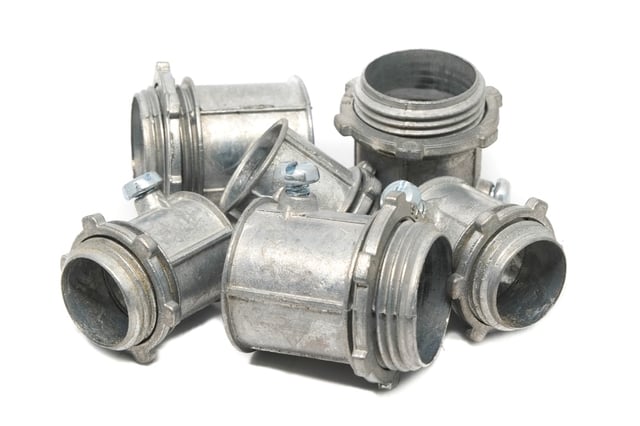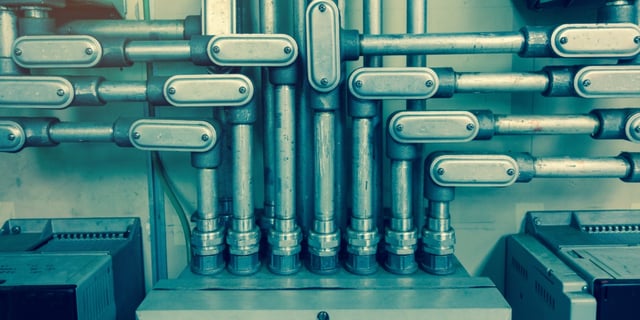Electrical Fittings for Metallic Conduit: Types and Their Applications

Electrical wiring depends on conduit for protection, while pull boxes and junction boxes simplify circuit handling. However, these elements must be firmly attached to each other to have a safe electrical installation. In addition, they must also be provided with structural support. These functions are carried out by electrical fittings, and there are many types in the market.
This article will provide an overview of the most common types of electrical fittings, along with their applications and some general guidelines for correct use. Keep in mind that fittings are different for metallic and nonmetallic conduit - this article will focus on those designed for metallic conduit. Note that some electrical fittings may be available in different versions, and each brings advantages and disadvantages, like in any engineering decision.
Our experienced electrical engineers can help you meet the NEC and local codes.
Using fittings incorrectly is not only dangerous, it goes against construction codes and may lead to modification requests and legal action from the NYC Department of Buildings. By working with qualified electrical design engineers, you can ensure that all electrical materials and equipment are properly specified.
The range of electrical fittings available commercially goes far beyond those described in this article. We will focus on the most common ones, but this is not an exhaustive list.
Couplings: Joining Conduit with Conduit
Couplings are used when you need to connect separate metallic conduit segments in the same circuit. There are three main mechanisms by which couplings perform their function:
- Threaded couplings simply have internal threads, as implied by their name, and they are used to join threaded conduit with ease (e.g. threaded RMC). Normally, this type of coupling is a single-piece fitting.
- Set-screw couplings achieve a union with adjustable screws, to lock conduit in place once it has been inserted. Although the main body of a set-screw coupling is a single piece, the screws are normally removable.
- Compression couplings are normally three-piece fittings. The coupling has external threads and locknuts, in order to insert conduit and fix it in place by compression. Note that the threads are used by the locknuts, not the conduit.
Since set-screw and compression couplings are both intended for unthreaded conduit, electrical design engineers must often choose between them. Compression couplings are more expensive, but they grip the conduit all around its diameter, not at a single spot like set-screw fittings. However, set-screw fittings have a lower cost and easier to install, adapting to more locations because they are adjusted with a screwdriver - compression couplings need a wrench and may be difficult to install when space is reduced. Keep in mind that couplings must be rated for the type of conduit; for example, EMT couplings are for EMT conduit only, even if other types of conduit fit.
FMC and LFMC use a special type of screw-in coupling, similar to the central portion of a compression fitting, but without the locknuts. Note that there are also combination couplings, where each end is intended for a different type of raceway. For example, you can find couplings that join RMC and LFMC.
Oversized conduit can make your installation much more expensive than necessary. Keep in mind that conduit diameter determines the size of fittings, so you end up with oversized fittings as well.
Connectors: Joining Conduit with Electrical Boxes

Connectors are used to join metallic conduit with pull boxes, junction boxes and other electrical enclosures. Metallic boxes typically come with knockout holes, which are designed to insert connectors. The connector attaches to the electrical box with a thread and lock-nut, while conduit is attached with similar methods as those used for connectors:
- For conduit types EMT, IMC and RMC, there are both set-screw and compression connectors.
- Conduit types FMC and LFMC use a special type of screw-in connector that has a compression locknut.
- All-purpose connectors use a pair of screws to adjust a metallic grip, and they can be used with flexible conduit of smaller diameters, as well as armored and sheathed cable.
If you must change the position of a connector in an electrical box and have already opened a knock-out hole, there are seals available. Like in the case of couplings, compression connectors offer have a higher cost but offer a more rigid connection, while set-screw connectors have a lower cost and are easier to install in reduced spaces.
Straps and Strut Clamps: Attaching Conduit to Fixed Surfaces
Straps are used to fix conduit to surfaces. They have a U-shaped body that allows them to clip around the conduit, and have one or two extensions with holes for screws. Since conduit comes in a wide range of diameters, normally ranging from ½” to 6”, straps are also available in the corresponding sizes.
Strut clamps achieve a similar purpose, fixing conduit to surfaces, but the design differs. A c-shaped strut is connected to a surface with screws, and the clamps are then inserted into the strut, held in place by hook-shaped legs. Each clamp is made of two identical halves that are joined with a screw at their intersection, holding conduit in place.
When dealing with a single conduit run, straps are the most practical solution. However, strut clamps are very useful when there are parallel conduit runs, since the same strut segment can hold several clamps.
Elbows: Conduit Direction Change
Elbows are short conduit segments that are manufactured with a specified turn angle, typically 90° or 45°. Being conduit themselves, they are normally connected to straight conduit runs by using couplings - threaded, set-screw or compression. Just keep in mind that threaded elbows required threaded couplings, otherwise there is choice between set-screw and compression.
Metallic conduit can be bent, so elbows may be avoided in many cases. EMT of smaller diameters tends to be easy to bend, so elbows are rarely needed. The difficulty of bending increases as conduit diameter becomes larger, or if you are dealing with the more rigid types: IMC and RMC. A hand bender is generally useful for EMT of small diameter.
Conduit Bodies: Combined Pull Box and Direction Change

Conduit bodies are among the most versatile and useful electrical fittings, since they can be opened to serve as a pull box, while allowing a change of direction if needed. There are also T-shaped conduit boxes with two openings along the same axis, plus another opening at a 90° angle in case two circuits must run in different directions. Electrical engineers can specify conduit bodies to eliminate junction boxes in close proximity with bent turns or elbows, since conduit bodies can perform the function of both.
General Recommendations
Electrical fittings offer choice and versatility, but that also means there is plenty of room for error when dealing with them. Working with a qualified MEP engineering firm ensures your electrical installations are code-compliant, while minimizing the material requirements. MEP engineers use software to simulate the electrical installation layout before actual construction, allowing a reduction of the total conduit length in the project, which also reduces the amount of fittings.

Ankit Javeri
Ankit is the Project Manager at NY Engineers, who holds an M.Tech. Some of his projects includes Community Access, Jackson Avenue
Join 15,000+ Fellow Architects and Contractors
Get expert engineering tips straight to your inbox. Subscribe to the NY Engineers Blog below.

